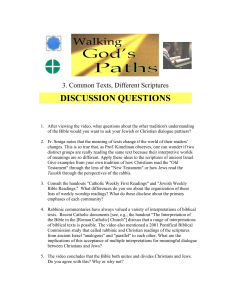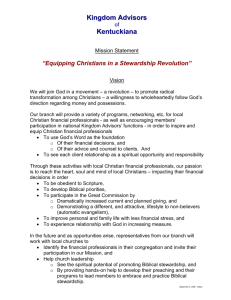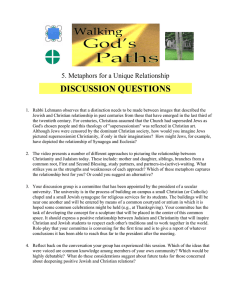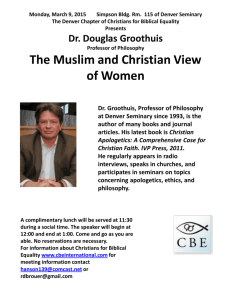FACILITATOR’S GUIDE 3. Common Texts, Different Scriptures
advertisement
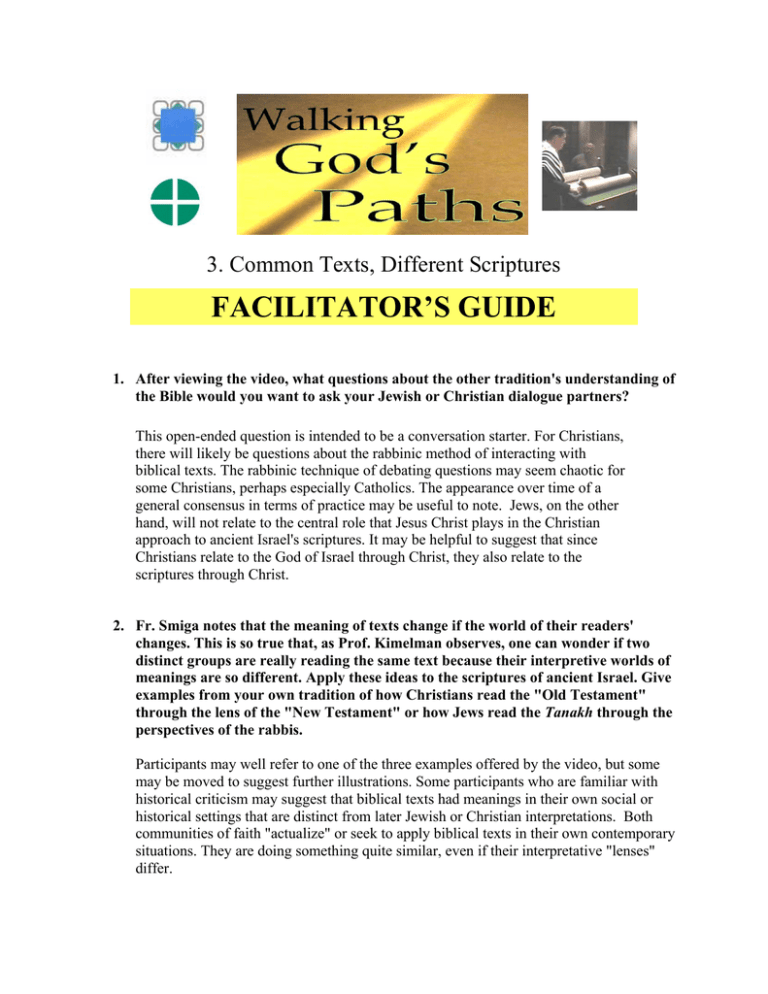
3. Common Texts, Different Scriptures FACILITATOR’S GUIDE 1. After viewing the video, what questions about the other tradition's understanding of the Bible would you want to ask your Jewish or Christian dialogue partners? This open-ended question is intended to be a conversation starter. For Christians, there will likely be questions about the rabbinic method of interacting with biblical texts. The rabbinic technique of debating questions may seem chaotic for some Christians, perhaps especially Catholics. The appearance over time of a general consensus in terms of practice may be useful to note. Jews, on the other hand, will not relate to the central role that Jesus Christ plays in the Christian approach to ancient Israel's scriptures. It may be helpful to suggest that since Christians relate to the God of Israel through Christ, they also relate to the scriptures through Christ. 2. Fr. Smiga notes that the meaning of texts change if the world of their readers' changes. This is so true that, as Prof. Kimelman observes, one can wonder if two distinct groups are really reading the same text because their interpretive worlds of meanings are so different. Apply these ideas to the scriptures of ancient Israel. Give examples from your own tradition of how Christians read the "Old Testament" through the lens of the "New Testament" or how Jews read the Tanakh through the perspectives of the rabbis. Participants may well refer to one of the three examples offered by the video, but some may be moved to suggest further illustrations. Some participants who are familiar with historical criticism may suggest that biblical texts had meanings in their own social or historical settings that are distinct from later Jewish or Christian interpretations. Both communities of faith "actualize" or seek to apply biblical texts in their own contemporary situations. They are doing something quite similar, even if their interpretative "lenses" differ. 3. Consult the handouts "Catholic Weekly First Readings" and "Jewish Weekly Bible Readings." What differences do you see about the organization of these lists of weekly worship readings? What do these disclose about the primary emphases of each community? Many different observations are possible. The Christian readings are small excerpts from the larger biblical section, while the Jewish readings present the entire passage. The Christian first reading is devised to relate to the gospel reading of the day, and somewhat similarly the Jewish haftarah reading is meant to recall a key point of the Torah reading of the day. Of major significance is the fact that the Christian readings are predominantly drawn from the prophetic books, not from the Torah. The Jewish principle readings are, of course, entirely drawn from the Torah (while the haftarah selections come from the prophetic books, they are much shorter and have some thematic connection with the principal reading from the Torah). The Christian preference for prophetic passages relates to the ending of the Christian canon of the "Old Testament" with a prophetic book. The symbolic character of many prophetic texts more readily lend themselves to being read in reference to Jesus Christ. 4. Rabbinic commentaries have always valued a variety of interpretations of biblical texts. Recent Catholic documents [see, e.g., the handout "The Interpretation of the Bible in the [Roman Catholic] Church"] discuss that a range of interpretations of biblical texts is possible. The video also mentioned a 2001 Pontifical Biblical Commission study that called rabbinic and Christian readings of the scriptures from ancient Israel "analogous" and "parallel" to each other. What are the implications of this acceptance of multiple interpretations for meaningful dialogue between Christians and Jews? Recent Catholic documents affirm the spiritual value of rabbinic interpretations of the Bible. This is a major reversal of centuries of Christian teaching to the contrary. It enables biblical text study jointly undertaken by Jews and Christians in ways that have rarely if ever been possible before. This unprecedented circumstance poses challenges for Jews as well. Can Christian interpretations be considered by Jews to have religious value even though Jews do not share the Christ-centered orientation of their Christian dialogue partners? 5. The video concludes that the Bible both unites and divides Christians and Jews. Do you agree with this? Why or why not? This question should serve to summarize the key points of the discussion. Various defensible positions are possible, of course. However the conversation turns, it would certainly seem true that their sharing of many common texts put Jews and Christians into a relationship that is not to be found between any other two distinct religious communities.
